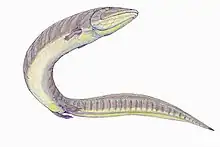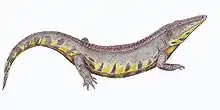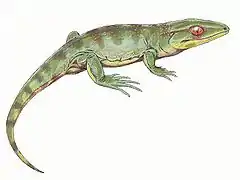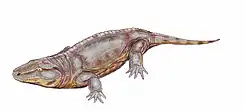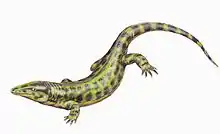| Ingentidens Temporal range: Upper Permian, | |
|---|---|
 | |
| Type jaw, Paleozoological Museum of China | |
| Scientific classification | |
| Domain: | Eukaryota |
| Kingdom: | Animalia |
| Phylum: | Chordata |
| Clade: | Reptiliomorpha |
| Order: | †Chroniosuchia |
| Family: | †Chroniosuchidae |
| Genus: | †Ingentidens Li & Cheng, 1999 |
| Species | |
Ingentidens is an extinct genus of chroniosuchid reptiliomorph from upper Permian (upper Roadian age) mudstone deposits of Dashankou locality, Xidagou Formation of China.[1] It was first named by Jin-Ling Li and Zheng-Wu Cheng in 1999, from a mandible (IGCAGS V 363). The type species is Ingentidens corridoricus. The generic name means “large” (Inget in Latin) + “tooth” (dens), and the specific name referring to the region of Gansu, the Hexi Corridor where the type specimen was found.[1]
References
- 1 2 Jin-Ling Li; Zheng-Wu Cheng (1999). "New Anthracosaur and Temnospondyl Amphibians from Gansu, China - The Fifth Report on Late Permian Dashankou Lower Tetrapod Fauna" (PDF). Vertebrata PalAsiatica. 37 (3): 234–247.
This article is issued from Wikipedia. The text is licensed under Creative Commons - Attribution - Sharealike. Additional terms may apply for the media files.
